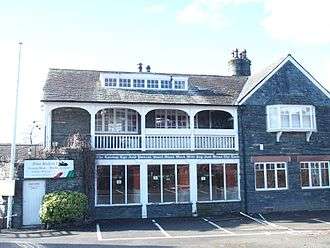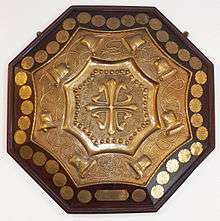Keswick School of Industrial Art

Keswick School of Industrial Art (KSIA) was founded in 1884 by Canon Hardwicke Rawnsley and his wife Edith as an evening class in woodwork and repoussé metalwork at the Crosthwaite Parish Rooms, in Keswick, Cumbria.[1] The enterprise, designed to alleviate unemployment, prospered, and within ten years more than a hundred men were attending classes. A new building was erected for the school at a nearby site.
The school closed in 1984 and the building became a restaurant.
History

Rawnsley was the vicar of Crosthwaite, at the edge of Keswick, from 1883 to 1917. He was one of the three co-founders of the National Trust and was a prominent figure in philanthropic enterprises in the area, helping to establish a grammar school, a hospital and a farm school.[2][3]
Inspired by the precepts of John Ruskin, Rawnsley and his wife set up free evening classes in the parish rooms, beginning in November 1884, to teach metalwork and wood carving under the supervision of a London professional woodcarver and a local jeweller.[4] In the winter months there was considerable unemployment in the town; the Rawnsleys provided training in skills that could alleviate the problem.[1]
The school prospered and swiftly developed a reputation for high quality copper and silver decorative metalwork. By 1888 nearly seventy men were attending the classes.[1] By 1890 the school was exhibiting nationally and winning prizes;[5] Its numbers now more than a hundred, it had outgrown its cramped home in the parish rooms, and Rawnsley raised funds for a purpose-built school nearby. Among his supporters were Walter Crane, Holman Hunt, and G F Watts.[6] The new building, to which the school moved in 1894, was designed by the Lancaster architects Paley and Austin at a cost of £1,300.[6] The workrooms were on the ground floor, with the showroom and a library on the upper floor. Beneath the balcony of the façade is the slogan:
The loving eye and skilful hand
Shall work with joy and bless the land
The school was mainly financed from sales of its products. Its funds became inadequate in the 1980s, from a combination of inadequate marketing and cheaper imported goods. The school closed in 1984.[7] Keswick Museum and Art Gallery displays a range of the school's works. The building, with its façade intact, became a restaurant.[7]
See also
Notes
- 1 2 3 Bott, p. 117
- ↑ Murphy, Graham. "Rawnsley, Hardwicke Drummond (1851–1920)", Oxford Dictionary of National Biography, Oxford University Press, 2004, retrieved 2 October 2014 (subscription or UK public library membership required)
- ↑ Rice, p. 106
- ↑ Rawnsley, p. 121
- ↑ "The School of Industrial Arts at Keswick". The Manchester Guardian, 5 April 1894, p. 8
- 1 2 Rawnsley, p. 124
- 1 2 Bott, p. 119
References
- Bott, George (1994). Keswick – The Story of a Lake District Town. Carlisle: Cumbria County Library. ISBN 978-0-905404-51-6.
- Rawnsley, Hardwicke (2011) [1901]. Ruskin and the English Lakes. Cambridge: Cambridge University Press. ISBN 978-1-108-03600-9.
- Rice, H A L (1974). Lake Country Towns. London: Robert Hale. ISBN 978-0-7091-4450-2.
Further reading
- Brunton, Jennie (2001). The Arts and Crafts Movement in the Lake District: a Social History. Lancaster: Centre for North-West Regional Studies, University of Lancaster. ISBN 978-1-86220-111-8.
- Bruce, Ian (2001). The Loving Eye and Skilful Hand: The Keswick School of Industrial Arts. Carlisle: Bookcase. OCLC 80891576.
Coordinates: 54°36′17″N 3°08′41″W / 54.6046°N 3.1448°W